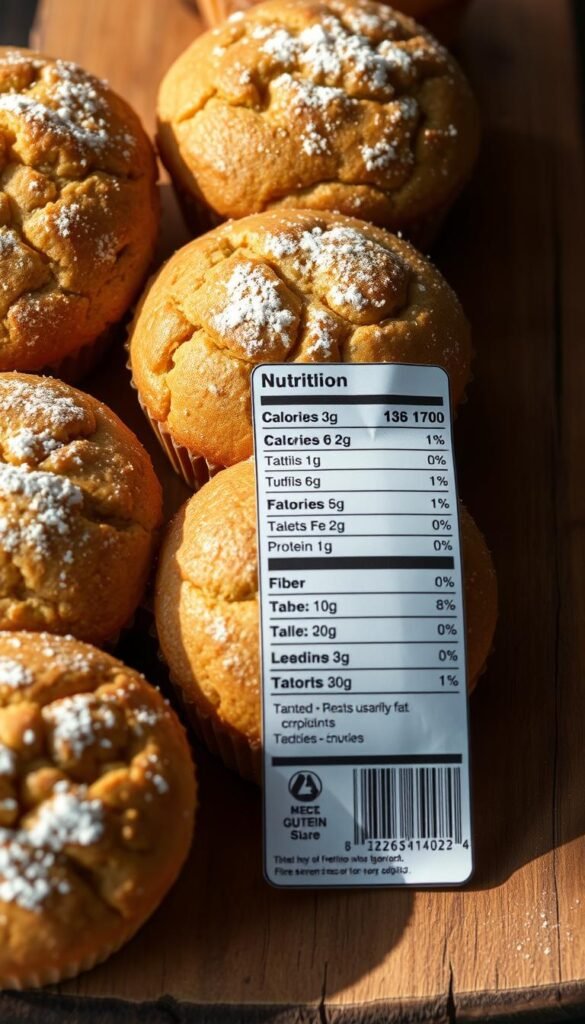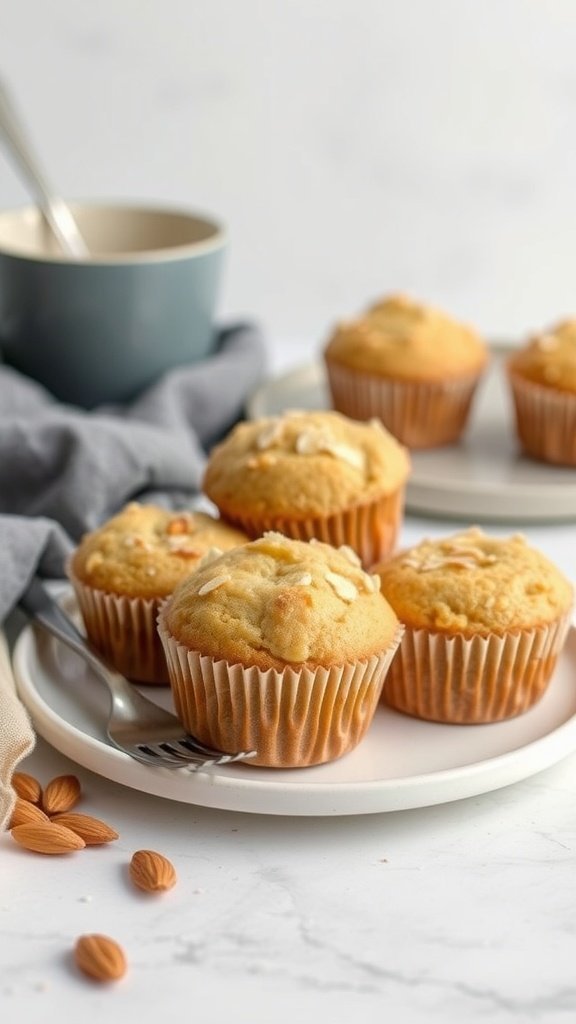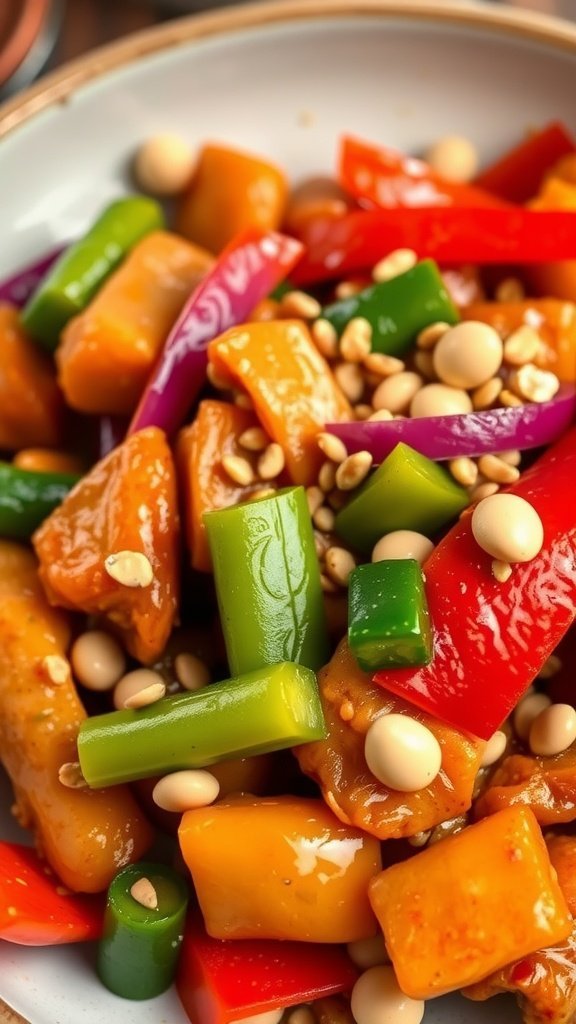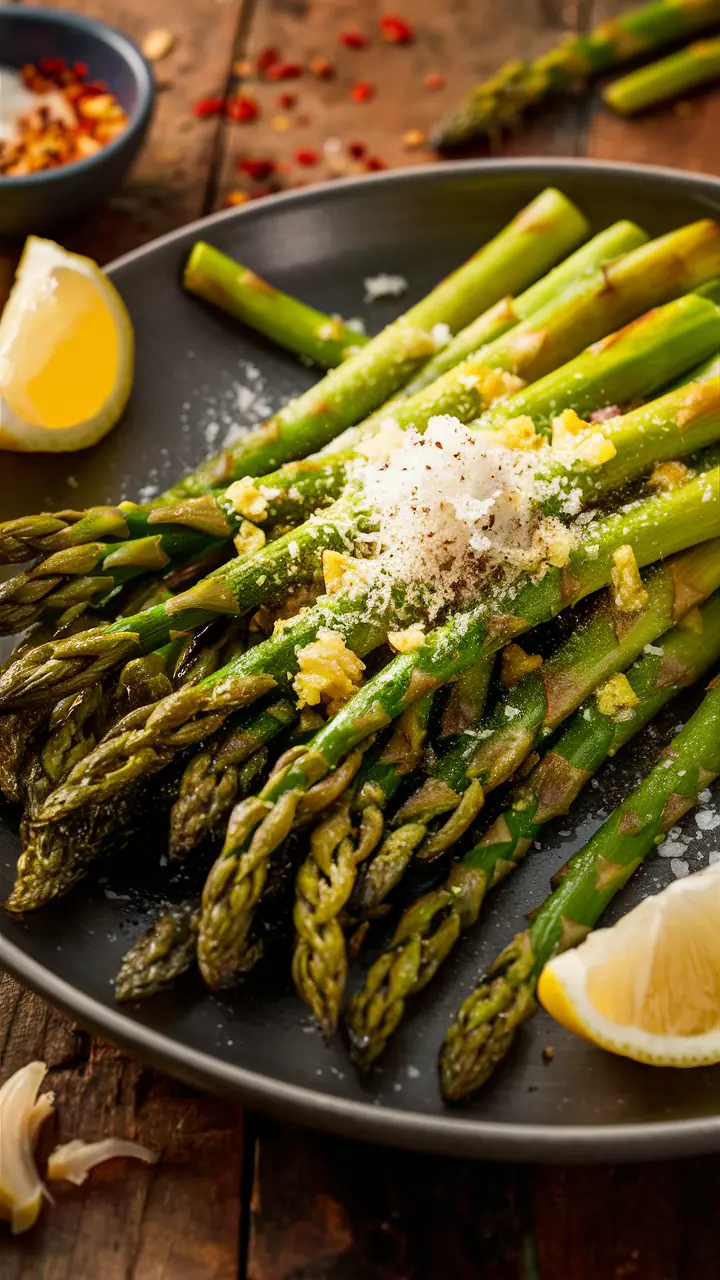Gluten-Free Almond Flour Muffins
This post may contain affiliate links. If you click and buy, we may earn a small commission at no extra cost to you. Learn more.
Welcome to the world of healthy baking! I’m excited to share this amazing recipe with you. These treats are moist, fluffy, and super tasty. Plus, they don’t have wheat!
If you have celiac disease, gluten sensitivity, or just want something healthier, these gluten-free muffins are perfect. I’ve worked hard to make this recipe just right. You’ll love how tender and flavorful they are.
They’re great for breakfast, snacks, or dessert. And the best part? Nobody will know they’re wheat-free! This is one of my favorite almond flour recipes. It always turns out amazing. Let’s make something special in your kitchen with these celiac-friendly treats.
Contents
- 1 Why Choose Almond Flour for Gluten-Free Baking
- 2 Essential Ingredients for Gluten-Free Almond Flour Muffins
- 3 Required Equipment and Tools
- 4 Preparing Your Kitchen and Ingredients
- 5 Step-by-Step Mixing Process
- 6 Baking Techniques for Optimal Results
- 7 Cooling and Storage Methods
- 8 Popular Flavor Variations
- 9 Troubleshooting Common Issues
- 10 Nutritional Information and Health Benefits
- 11 Serving Suggestions and Pairings
- 12 Gluten-Free Almond Flour Muffins
- 13 Conclusion
- 14 FAQ
- 14.1 Can I substitute regular flour for almond flour in this recipe?
- 14.2 How do I know if my almond flour is fresh enough to use?
- 14.3 Why are my muffins dense instead of light and fluffy?
- 14.4 Can I make these muffins dairy-free?
- 14.5 How long do these gluten-free muffins stay fresh?
- 14.6 Can I use almond meal instead of almond flour?
- 14.7 What’s the best way to measure almond flour accurately?
- 14.8 Can I add fresh fruit to these muffins?
- 14.9 Why did my muffin tops sink after baking?
- 14.10 Are these muffins suitable for people with celiac disease?
- 14.11 Can I make mini muffins with this recipe?
- 14.12 What should I do if my batter seems too thick?
Key Takeaways
- These muffins are perfect for people with celiac disease or gluten sensitivity
- The recipe uses nutrient-rich ingredients for a healthier alternative to traditional baked goods
- They’re incredibly moist and fluffy, rivaling any wheat-based version
- Perfect for breakfast, snacks, or dessert occasions
- Nobody will guess they’re made without traditional wheat products
- The recipe has been perfected through extensive testing for consistent results
Why Choose Almond Flour for Gluten-Free Baking
Almond flour is my top pick for gluten-free baking. It turns simple recipes into extraordinary treats that everyone will adore. When searching for gluten-free flour alternatives, almond flour stands out. It makes gluten-free baking almost undetectable.
Nutritional Benefits of Almond Flour
The almond flour benefits are vast and impressive. It’s not just gluten-free; it’s a nutritional powerhouse. With 6 grams of protein per quarter cup, it’s great for protein-rich baking.
It’s also rich in healthy fats, vitamin E, and magnesium. Unlike regular wheat flour, almond flour keeps blood sugar stable. This makes it perfect for low-carb muffins that are delicious without the sugar crash.
Texture and Taste Advantages
Almond flour truly excels in texture – it’s absolutely divine! It makes muffins incredibly moist and tender with a rich crumb. Say goodbye to dry, crumbly muffins!
The subtle nutty sweetness adds a luxurious flavor that makes each bite special. Your family will be amazed that these treats are gluten-free!
Comparison with Other Gluten-Free Flours
Almond flour beats other options hands down! Rice flour can be gritty and tasteless. Coconut flour is too absorbent and hard to work with.
Almond flour is forgiving and consistent, making it easy to achieve bakery-quality results. It’s the go-to flour for protein-rich baking success!
Essential Ingredients for Gluten-Free Almond Flour Muffins
Starting your gluten-free pantry staples is key to making great muffins! The right muffin ingredients work together like a dance. Each part is important for those soft, fluffy muffins we love.
Primary Ingredients and Their Roles
Finely ground almond flour is the main ingredient. It’s different from almond meal because it’s finer. This finer texture gives the muffins the right crumb.
Eggs are the binding heroes, adding structure and lift. They keep everything together beautifully! Honey or pure maple syrup add sweetness and moisture. Baking powder makes the muffins rise, and a little salt brings out all the flavors.
Optional Add-ins and Flavor Enhancers
Now, let’s add some magic! Fresh blueberries, dark chocolate chips, or chopped walnuts make muffins extra special. Vanilla extract adds depth, and a bit of lemon zest brightens everything up!
Cinnamon, nutmeg, or fresh herbs like rosemary can create unique flavors. It’s fun to try new things!
Ingredient Substitution Guidelines
Sometimes, we run out of ingredients. For egg alternatives, flax eggs are great for vegan baking. Mix one tablespoon of ground flaxseed with three tablespoons of water for each egg.
These baking substitutions might change the texture a bit. But don’t worry if it’s not perfect at first. Coconut oil is a good butter substitute, and stevia can replace honey. Keep track of what works for you, and you’ll find your own special recipes!
Required Equipment and Tools
Starting with gluten-free almond flour muffins is easy. You likely have most of what you need in your kitchen already.
Simple, reliable baking tools are key. They ensure your muffins turn out great every time.
Basic Baking Equipment
Begin with a 12-cup muffin tin. Non-stick muffin pans make removing muffins a breeze.
Medium and large mixing bowls are next. A whisk or wooden spoon is all you need for mixing. These tools have helped me make countless perfect muffins!
Measuring Tools for Accuracy
Accuracy is vital in gluten-free baking. Standard measuring cups and spoons work well for most recipes.
A kitchen scale is your best friend. It ensures your muffins are consistent. I find my muffins better when I weigh the almond flour.
Optional Equipment for Better Results
While not necessary, some extras enhance your baking. Paper liners prevent sticking and make cleanup easy. A rubber spatula helps get every bit of batter.
An ice cream scoop makes muffins even. A wire cooling rack ensures they cool properly. These small additions greatly improve your baking!
| Equipment Type | Essential Items | Optional Upgrades | Benefits |
|---|---|---|---|
| Baking | 12-cup muffin tin | Silicone muffin cups | Easy removal and cleanup |
| Mixing | Mixing bowls, whisk | Stand mixer | Consistent mixing results |
| Measuring | Cups and spoons | Digital kitchen scale | Precise ingredient ratios |
| Finishing | Basic cooling rack | Multi-tier cooling system | Proper texture development |
Preparing Your Kitchen and Ingredients
The magic of baking starts before you mix. Proper baking preparation makes all the difference. Follow these steps for success!
Setting Up Your Workspace
Clear your counters and gather all you need in one spot. Missing an ingredient mid-mix is frustrating. Keep your tools within reach and work comfortably.
An organized workspace makes baking smoother. You’ll feel more confident and relaxed.
Ingredient Temperature and Preparation
Room temperature ingredients are key for perfect muffins! Take eggs out 30 minutes before baking. Cold eggs make muffins dense.
Forgot to take eggs out early? Warm them in water for 5-10 minutes. Also, make sure almond flour is at room temperature for better mixing.
Preheating and Pan Preparation
Oven preheating takes 15 minutes. Start this before mixing. Set your oven to 350°F and let it heat up.
For muffin pan prep, grease it with butter or use paper liners. I prefer liners for an easy removal and a bakery look!
Step-by-Step Mixing Process
The mixing process is where magic happens! It’s the core of making perfect gluten-free almond flour muffins. The right muffin mixing technique is key to getting light, fluffy muffins.
Combining Dry Ingredients
Begin by using a large mixing bowl for your dry ingredients. Add almond flour, baking powder, salt, and any dry spices. Here’s my secret – whisk these ingredients well!
Whisking breaks up clumps in the almond flour. It also spreads out the baking powder evenly. This prevents uneven rising in your muffins.
Preparing Wet Ingredients
In another bowl, beat your eggs until they’re light and frothy. This adds wonderful lift to your muffins! Then, whisk in honey or maple syrup, melted butter or oil, and vanilla extract.
Make sure everything is well combined and smooth. Room temperature ingredients mix better than cold ones.
Proper Mixing Techniques
Now, it’s time to mix your wet and dry ingredients together! Pour the wet mixture into the dry ingredients. Use a rubber spatula or wooden spoon to gently fold everything together.
Avoiding Overmixing
Many bakers make the mistake of overmixing prevention. Mix just until the ingredients come together. A few lumps are okay.
Overmixing makes the muffins tough and dense. Stop mixing when you don’t see dry flour anymore.
Achieving the Right Consistency
Your batter should be thick but pourable, like thick pancake batter. It should fall off your spoon in ribbons.
If it’s too thick, add a tablespoon of milk. Too thin? Add a bit more almond flour. This ensures perfectly domed muffins every time!
Baking Techniques for Optimal Results
Transform your kitchen into a bakery with these muffin baking tips! The right technique can turn good muffins into amazing ones. Let’s dive into the secrets for baking like a pro every time.
Filling Muffin Cups Correctly
Fill each muffin cup about 2/3 full for even-sized muffins. An ice cream scoop makes dividing the batter easy and keeps it uniform.
For those bakery-style dome tops, fill them about 3/4 full. Keep an eye on them as they’ll rise faster. Make sure each cup has roughly the same batter amount.
Oven Temperature and Timing
Set your oven temperature to 350°F for almond flour muffins. Baking time is 18-22 minutes. Start checking at 18 minutes to avoid overbaking.
Rotate your muffin pan halfway through baking. This ensures even browning and prevents hot spots.
Testing for Doneness
The doneness test is the best part! Insert a toothpick into the muffin’s center. It should come out with a few moist crumbs. If it’s clean, they might be overbaked.
Try the bounce-back test too. Gently press the top; if it springs back, they’re perfect. Your nose can also tell when they’re ready – when your kitchen smells amazing, they’re done!
| Baking Stage | Temperature | Time Range | Visual Cues |
|---|---|---|---|
| Initial Baking | 350°F | 0-10 minutes | Batter sets, slight rise begins |
| Mid-Baking | 350°F | 10-15 minutes | Tops start browning, full rise |
| Final Stage | 350°F | 15-22 minutes | Golden brown, springs back when touched |
| Doneness Check | 350°F | 18+ minutes | Toothpick with few moist crumbs |
Cooling and Storage Methods
When your gluten-free almond flour muffins come out of the oven, you’ll have to wait! But don’t worry, the right muffin storage and cooling methods are key. They make all the difference between delicious muffins and ones that are not so great.
Proper Cooling Techniques
Let the muffins rest in the pan for five minutes first. This helps them not crumble when you take them out. Then, gently place them on a cooling rack.
If you don’t have a wire rack, a clean kitchen towel works well too. The important thing is to let air circulate around the muffins for even cooling.
Short-term Storage Solutions
For food preservation at room temperature, keep cooled muffins in an airtight container for 2-3 days. I always put a paper towel at the bottom to soak up extra moisture!
In humid places, refrigerate them instead. They’ll stay fresh for up to a week this way.
Long-term Storage and Freezing
My favorite trick is to freeze muffins individually! Wrap each cooled muffin in plastic wrap, then put them in freezer bags for up to three months.
To enjoy, thaw at room temperature for an hour, or microwave frozen ones for 30-45 seconds. It’s like having a bakery in your freezer!
| Storage Method | Duration | Best For | Tips |
|---|---|---|---|
| Room Temperature | 2-3 days | Quick consumption | Use paper towel in container |
| Refrigerated | Up to 1 week | Humid climates | Airtight container essential |
| Frozen | Up to 3 months | Meal prep | Wrap individually first |
Popular Flavor Variations
Turn your basic almond flour muffin recipe into exciting flavor adventures! Almond flour pairs well with many muffin flavors. You can make classic favorites or unique gourmet combinations.
Each variation uses the same simple technique. Just fold your chosen add-ins into the batter at the end of mixing. This prevents overmixing and ensures even distribution in your muffins.

Berry and Fruit Combinations
Fresh and frozen berries make the most beloved blueberry muffins and more! Add about ¾ cup of fresh blueberries for those gorgeous purple streaks. Raspberries bring lovely tartness, while diced strawberries add natural sweetness.
Try combining lemon zest with blueberries for a bright, sunny flavor. Dried cranberries or chopped dried apricots work wonderfully too. Pro tip: Toss berries in a little almond flour before folding them in to prevent sinking!
Chocolate and Nut Variations
Chocolate lovers will adore these chocolate chip variations! Mini chocolate chips create perfect pockets of melty goodness. Use about ½ cup for the ideal chocolate-to-muffin ratio.
For rich chocolate muffins, replace ¼ cup of almond flour with unsweetened cocoa powder. Add chopped walnuts or pecans for delightful crunch. Dark chocolate chunks create an absolutely luxurious experience!
Spice and Herb Infusions
Create sophisticated spiced muffins with warming spices and fresh herbs. Cinnamon and nutmeg make cozy fall treats. Cardamom adds an exotic, aromatic touch that’s simply divine.
Try fresh rosemary with lemon zest for a surprisingly amazing combination! Ginger and orange zest create bright, warming flavors. Start with ½ teaspoon of spices and adjust to taste.
| Flavor Category | Popular Combinations | Amount to Add | Special Tips |
|---|---|---|---|
| Berry & Fruit | Blueberry-Lemon, Strawberry-Vanilla | ¾ cup fresh/frozen | Dust with almond flour first |
| Chocolate & Nuts | Chocolate Chip-Walnut, Cocoa-Pecan | ½ cup chips/nuts | Use mini chips for better distribution |
| Spice & Herbs | Cinnamon-Apple, Rosemary-Lemon | ½ teaspoon spices | Start small and taste-test |
| Creative Blends | Orange-Cranberry, Ginger-Pear | Varies by ingredient | Balance sweet and tart flavors |
Troubleshooting Common Issues
Sometimes, our muffins don’t turn out as we hoped. But that’s okay! Even experienced bakers face baking problems, often with gluten-free ingredients. Most issues have simple fixes, and I’m here to help you solve them all!
Understanding what went wrong helps you improve with each batch. These troubleshooting tips will turn your baking mishaps into learning opportunities.
Dense or Heavy Muffins
Heavy, dense muffins often come from overmixing the batter. Vigorous stirring can toughen the texture. Just mix until the ingredients come together – lumps are okay!
Too much almond flour or not enough leavening can also cause dense muffins. Make sure your baking powder is fresh. Old leavening agents won’t help your muffins rise.
Dry or Crumbly Texture
When muffins are dry, they need more moisture. Try adding an extra egg yolk, a tablespoon of Greek yogurt, or a bit more oil. Almond flour absorbs differently by brand, so adjust as needed.
Overbaking can also make muffins dry. Even a few extra minutes can dry them out. Start checking for doneness a few minutes before the recommended time.
Sunken or Flat Tops
Flat, sunken muffins are fixable! This often happens if your oven temperature is too low or your baking powder isn’t working. Always preheat your oven completely and consider using an oven thermometer.
Many home ovens run cooler than their display shows. If your muffins consistently fall flat, try increasing the temperature by 25°F.
Temperature-Related Problems
If your muffins brown too quickly on top but stay raw inside, lower your oven temperature by 25°F and bake longer. If they’re taking forever to bake, your oven might be running cool.
Ingredient Ratio Issues
Getting ratios wrong can throw everything off balance. Too much liquid creates flat muffins, while too little makes them dense and heavy. Keep detailed notes about what works in your specific kitchen!
| Problem | Likely Cause | Quick Fix | Prevention |
|---|---|---|---|
| Dense muffins | Overmixing batter | Mix less next time | Fold until just combined |
| Dry texture | Overbaking or insufficient moisture | Add more liquid ingredients | Check doneness early |
| Flat tops | Low oven temperature | Increase temperature 25°F | Use oven thermometer |
| Uneven baking | Hot spots in oven | Rotate pan halfway through | Know your oven’s quirks |
Baking is both science and art! Every kitchen is different, and each “failed” batch teaches you something valuable. Don’t get discouraged – I’ve made countless imperfect muffins on my journey to perfection, and now you benefit from all those lessons!
Nutritional Information and Health Benefits
Discover the nutritional wonders of these healthy muffins and enjoy them guilt-free! These almond flour treats are packed with nutrition facts that outshine traditional wheat muffins. They offer a satisfying snack that’s good for your body.
Caloric Content and Macronutrients
Each muffin has about 180-220 calories, depending on what you add. They’re rich in protein, with 6-8 grams per muffin. This comes from almond flour and eggs.
The healthy fats in almonds keep you full longer than regular muffins. They have much lower carbs, about 8-12 grams. This is compared to 25-30 grams in wheat-based muffins!

Dietary Advantages
These muffins are great for many diets. They’re gluten-free, perfect for those with celiac disease or sensitivity. They’re also great for paleo diets and low-carb baking.
Almond flour is full of vitamin E, magnesium, and fiber. These nutrients help your heart and keep your blood sugar stable. Plus, you control every ingredient, unlike store-bought muffins with preservatives.
Portion Control Guidelines
Enjoy one muffin as a satisfying snack or two for a big breakfast. They’re filling thanks to protein and healthy fats. You won’t crave more food soon!
It’s important to enjoy each bite slowly. These muffins are rich and filling. A little goes a long way in keeping your healthy lifestyle on track.
| Nutrient | Almond Flour Muffin | Regular Wheat Muffin | Health Advantage |
|---|---|---|---|
| Calories | 180-220 | 250-350 | Lower caloric density |
| Protein (g) | 6-8 | 3-5 | Better satiety |
| Carbs (g) | 8-12 | 25-30 | Blood sugar friendly |
| Fiber (g) | 3-4 | 1-2 | Improved digestion |
Serving Suggestions and Pairings
Make your muffin experience better with these muffin serving ideas and tasty pairings! These almond flour treats are perfect for any event. They’re great for a simple breakfast or a fancy brunch.
Morning and Brunch Combinations
Begin your day with these amazing breakfast pairings! I enjoy serving these muffins with Greek yogurt and fresh berries. The creamy yogurt and the nutty almond flavor are a perfect match.
For a full brunch menu, add scrambled eggs and seasonal fruit. They also pair well with almond butter or cream cheese for extra taste and protein.
Perfect Snack Matches
These muffins are great for an afternoon snack! Try them with mixed nuts or sharp cheddar cheese. This mix gives you energy and tasty flavors.
Kids love them in lunchboxes with apple slices or string cheese. They’re healthy, so you can feel good about it!
Ideal Drink Partners
The coffee combinations are endless and delicious! The almond flavor goes well with both light and dark roasts. Tea fans will enjoy them with Earl Grey or chamomile.
For a special treat, try them with chai lattes or golden milk. Berry or tropical smoothies make great contrasts.
| Meal Time | Food Pairing | Beverage Match | Occasion |
|---|---|---|---|
| Breakfast | Greek yogurt & berries | Medium roast coffee | Daily routine |
| Brunch | Scrambled eggs & fruit | Mimosa or tea | Weekend gathering |
| Snack | Almond butter | Green tea | Afternoon energy |
| Dessert | Cream cheese frosting | Hot cocoa | Evening treat |
Gluten-Free Almond Flour Muffins
Ingredients
- 2 1/2 cups finely ground almond flour
- 1/2 tsp baking soda
- 1/2 tsp sea salt
- 3 large eggs
- 1/4 cup honey or pure maple syrup
- 1/4 cup melted coconut oil or butter
- 1 tsp vanilla extract
- Optional: 1/2 cup blueberries, chocolate chips, or chopped nuts
Instructions
- Preheat oven to 350°F (175°C). Line or grease a 12-cup muffin tin.
- In a medium bowl, whisk together almond flour, baking soda, and salt.
- In a separate large bowl, whisk eggs, honey, oil, and vanilla until smooth.
- Add dry ingredients to wet and stir until just combined. Fold in optional add-ins if using.
- Spoon batter evenly into muffin cups, filling each about 2/3 full.
- Bake for 18–22 minutes or until golden and a toothpick inserted comes out with moist crumbs.
- Let cool in the pan for 5 minutes, then transfer to a wire rack to finish cooling.
Conclusion
You now have all the tools and knowledge to create amazing gluten-free almond flour muffins. These homemade muffins show that gluten-free baking is possible in your own kitchen.
Every batch you make boosts your baking confidence. Don’t worry if your first attempt isn’t perfect. I’ve been there too, and each time you bake, you learn something new.
These muffins are great healthy breakfast options for your family. They’re packed with nutritious almond flour and wholesome ingredients. Plus, you control exactly what goes into every bite.
Start with the basic recipe, then let your creativity shine! Add blueberries for a classic twist, chocolate chips for an indulgent treat, or cinnamon for warm spice notes. The possibilities are endless once you master the foundation.
Your kitchen will smell incredible when these golden beauties are baking. There’s something magical about creating homemade muffins from scratch. It fills your home with warmth and your heart with pride.
So grab your mixing bowl and measuring cups! Your gluten-free baking success story starts right now. These muffins are waiting to become your new favorite healthy breakfast options.








